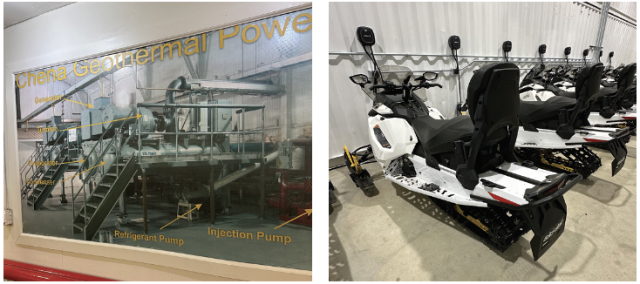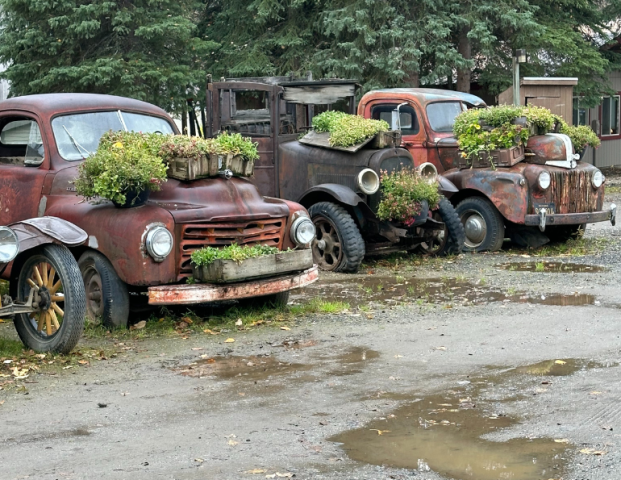As sustainability initiatives and emission reduction goals grow in importance in the resort industry, it is possible to break away from the energy grid using natural resources and build with recycled materials. Here’s how one resort is doing it, with a complete closed-loop system, which can serve as a model—or just inspiration—for others.
Picture a gleaming row of sparkling white, new-this-season electric snowmobiles parked in a brand-new garage built partially from recycled shipping containers. The snowmobiles are plugged in along a rail of charging units, which, along with the rest of the building, are powered by geothermal energy, which is also used to heat the facility. This a 100 percent off-the-grid operation.
This very building exists at Chena Hot Springs Resort, a lodging property and spa located about 60 miles from Fairbanks, Alaska. It offers several outdoor activities: cross-country skiing, snowmobile tours, dog sledding, and more. The building’s closed-loop system for its electric snowmobiles and e-bikes, some of which are for guest use and others for operational use, is just one example of how the resort utilizes renewables to run its operation—which is powered entirely by geothermal energy.
The resort also has geothermal-heated hydroponic greenhouses, which grow lettuce, tomatoes, cucumbers, zucchini, and other greens and veggies, harvested daily year-round for its restaurants.
The history. The use of renewable energy and a commitment to recycling are part of Chena’s DNA, thanks in large part to Bernie Karl and Connie Parks-Karl, who bought the resort from the state of Alaska in 1998 (and have since transferred ownership to the employees via an employee stock ownership plan). In addition to the shipping container garage, the front desk of the main lodging property is made from railroad carts and tracks from the Hard Rock Gold mine from 1898. The sitting bench in the lobby is a railroad axle, and the domed entrance to the lodge is from an airport walkway.
“Even our offices are recycled buildings from the North Slope,” a remote area in northern Alaska, says general manager Natasha Minnerly.
It’s a far cry from when the property was established in the early 1900s as an outpost for miners, when millions of dollars in gold was being panned from the Chena River and its many tributaries. Brothers Robert and Thom Swan discovered the mineral springs in 1905 and marketed them as recuperation for weary miners in what was then the rugged outback. Some of the original log cabins remain today, repurposed into private massage therapy facilities.
A Unique Facility
Far newer than the cabins, of course, is the aforementioned garage. It was built in summer 2024 to house snowmobiles, e-bikes, and other equipment. Outside, it looks like a nondescript, utilitarian garage with metal siding and a pitched roof, save for the doors of the shipping containers, which are visible on the gable ends.
Chena used 40-foot-long shipping containers stacked two high and three long on each side to create the outer walls of the 120-foot-long by 60-foot-wide garage that the resort also intends to fill with heavy equipment and utilize for other to-be-determined uses in the future. The ground level is 7,200 square feet. The containers, which are each 8 feet wide and more than 9 feet tall, also provide additional storage space.
Minnerly says the storage space inside each container—both the ground level and second-level containers—is used to store various items, including spare parts.
Cost savings. The total cost to construct the garage—including the shipping containers, siding, roof, lumber, and fixtures—was approximately $250,000. Even with the high cost of shipping something as large as a shipping container to Fairbanks and then to the resort, that is still far less expensive than the cost to build a conventional garage of this size and makes it an interesting model for ski areas to explore when considering how to build their next maintenance facility.
Another interesting investment the resort made in response to its remote location that saves costs was to install a huge 3D printing machine to create parts on demand instead of waiting weeks, even months, for delivery from Fairbanks, Anchorage, or from the Lower 48. The machine creates items such as planters for the greenhouse, vases for flowers, item displays, special fittings, replacement dash panels for vans, ventilation parts, and even gift shop souvenirs and signs for the resort.
Minnerly could not estimate how much the printer saves the resort each month year-round, especially in winter, when the only road from Fairbanks is often closed, other than to say it is a significant amount.
Geothermal-Powered
Chena Hot Springs Resort is named for its mineral springs, which not only feed a large shoulder-deep hot pool that’s open to guests year-round, but also power and heat all the resort’s facilities, not just the new garage.
The technology. The geothermal project began in 2006, when owner Bernie Karl installed Alaska’s first such operational facility with the help of the state government. Then, the two 200-kilowatt (kW) generators cost $2.1 million and displaced 150,000 gallons of diesel annually. Another condenser added in 2014 produces 320 kW on its own, producing a total of 720 kW of electricity, enough for 100 percent of the resort’s daily needs and eliminating the use of more than 250,000 gallons of diesel a year.
Until then, due to its remote location, the property had to rely on diesel generators for electricity, and there were many blackouts due to weather-related delivery problems. The geothermal power plants cut energy costs by 83 percent, and provide electricity for the resort, its live-on-site employees, and some local residents.
The super-heated geothermal water comes out of the ground at 165 degrees, so it does not require additional heating via boiler, as is the case in many other hot springs areas. Chena’s super-hot water is then mixed with refrigerant, turning it into steam, which is forced through a screw-drive to produce power.
Plant manager Steven Vandermass makes it sound simple. “It’s 100-year-old technology that allows us to produce electricity throughout this property year-round,” he says.
Education and tourism. The resort is proud of its energy innovations. The geothermal plant has a huge see-through window in the visitor area to view the generators, with helpful signs explaining each piece of equipment to visitors. The resort’s website also prominently features its various renewables projects and sustainable operating efforts.
Geothermal energy also powers the resort’s year-round Aurora Ice Museum. It keeps the huge igloo at below-freezing temperatures during the summer’s warmer weather and 16 hours or more of daily sunlight, preventing the ice sculptures (and the bar) inside from melting.
The resort offers free tours year-round of both the greenhouse and the geothermal plant, because owner Karl “wants to show them off,” says Minnerly. He is known throughout Alaska as a visionary, determined to wean consumers off oil, even though Alaska’s oil reserves fuel much of the state’s economy. The resort even recycles pieces from the Trans-Alaska Pipeline.
 Left to right: The window in the visitor area of the geothermal power plant is labeled to identify machine parts, including the condenser and pumps; The resort charges up its Ski-Doo electric snowmobiles to use for daytime outings, Aurora Borealis tours, and transport for resort ops staff.
Left to right: The window in the visitor area of the geothermal power plant is labeled to identify machine parts, including the condenser and pumps; The resort charges up its Ski-Doo electric snowmobiles to use for daytime outings, Aurora Borealis tours, and transport for resort ops staff.
Electric Snowmobiles
Chena’s new electric snowmobiles are Ski-Doo Grand Touring models. The resort is aiding Ski-Doo R&D by providing real-time data that will help improve its fledgling electric snowmobile product in an effort to better the experience both for guests that tour on them and employees that use them for work.
“They know the terrain and experience multiple winter conditions,” says Ski-Doo spokesperson Steve Cowing. “Their feedback is invaluable in ensuring that our products live up to our customers’ expectations. What we’ll learn are the same things an automotive fleet operator would like: recharging times and efficiency over many months and years, parts performance, and technical parameters.”
Ski-Doo aims to gather more subjective feedback, too. “We’ll also learn what people think about the product, such as if they appreciate the EV experience, improvements or changes they would like to see, etc. We’ll also learn what the operators like or not and how to best meet their needs as well as their customers,” adds Cowing.
The Grand Touring models have a range of about 31 miles between charges, enough for a short day-tour for guests or an evening excursion to see the Aurora Borealis, or for staff transport around the resort during the workday. They cost around $17,000 each.
Operationally intensive example. Chena Hot Springs Resort doesn’t have alpine skiing and riding or uphill transportation, but it’s an operationally intensive hospitality destination, meaning the nuts and bolts of the resort are very similar to a ski area. This makes its renewable energy and recycled-material construction projects an interesting case study for ski area operators.






